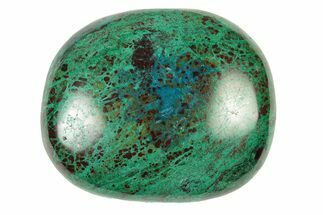This Specimen has been sold.
1.45" Atacamite & Chrysocolla Association - Peru
This colorful specimen consists of an association of vivid green atacamite crystals and sky-blue chrysocolla. It was collected from the Lily Mine in Pisco Umay, Peru and is 1.45" wide.
Atacamite is a secondary copper mineral that's formed from the oxidation of copper minerals. It has the chemical formula Cu₂Cl(OH)₃ and forms as slender prismatic crystals, fibrous crystals and as granular to compact aggregations. Atacamite was first described by D. de Fallizen after specimens found in the Atacama Desert of Chile in 1801.
Chrysocolla is a basic copper silicate that typically forms as a pseudomorph following other copper based minerals. The chemical formula is considered undetermined due to the varying substitutions of elements and water content in its chemical structure. However, there is a form of chrysocolla with an identifiable chemical formula of Cu2H2Si2O5(OH)4 that can be found in microcrystals.
Regularly, chrysocolla will form as botryoidal lumps and spheres, rarely forming visible crystals. It can also form in both solid and fibrous veins, over fibrous minerals, and in crusts. Known for its sharp and vibrant coloring, chrysocolla can display a wide variety of colors such as bluish-green, bright green, light blue, to even sometimes multicolored specimens depending on the atmosphere present during formation.
Regularly, chrysocolla will form as botryoidal lumps and spheres, rarely forming visible crystals. It can also form in both solid and fibrous veins, over fibrous minerals, and in crusts. Known for its sharp and vibrant coloring, chrysocolla can display a wide variety of colors such as bluish-green, bright green, light blue, to even sometimes multicolored specimens depending on the atmosphere present during formation.
Atacamite is a secondary copper mineral that's formed from the oxidation of copper minerals. It has the chemical formula Cu₂Cl(OH)₃ and forms as slender prismatic crystals, fibrous crystals and as granular to compact aggregations. Atacamite was first described by D. de Fallizen after specimens found in the Atacama Desert of Chile in 1801.
SPECIES
Atacamite & Chrysocolla
LOCATION
Lily Mine, Pisco Umay, Ica Department, Peru
SIZE
1.45" wide
CATEGORY
ITEM
#98127
 Reviews
Reviews













